Connect With Us
Patient Education
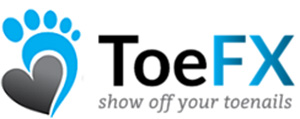
A fungal toenail infection can be difficult to live with. Not only does it cause changes in the texture and color of your toenails, but toenail fungus can also become painful and even dangerous to those who have conditions that affect their immune systems. Traditional treatments like topical ointments and oral antifungal drugs are not always effective, and often bring about unwanted side effects. Fortunately, there have been recent leaps in laser therapy for treating fungal nail infections.
ToeFX ClearToe Therapy is a safe, simple, and non-toxic laser treatment for toenail fungus. Using light to kill the fungus, it helps clear up fungal nail infections in as little as 6 to 10 treatment sessions. During the treatment process, a topical antimicrobial is applied to your nails. Next, the ClearToe Therapy Light is placed over your foot for 30 minutes at a time to kill the toenail fungus beneath the surface of the nails.
A research study looking at the efficacy of ToeFX ClearToe Therapy found that 97% of treated toes responded to the treatment, with 76% of studied toes showing excellent to outstanding results. If you suffer from toenail fungus, consult with a podiatrist today to see if this treatment may be right for you.
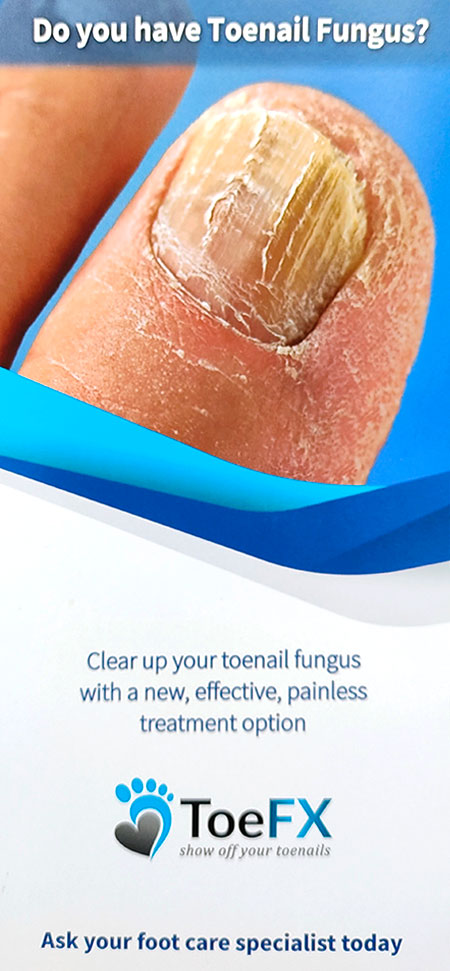
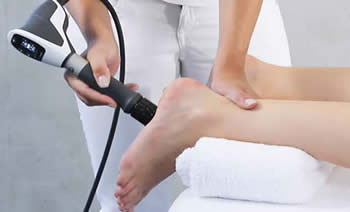
Shockwave therapy, or Extracorporeal Pulse Activation Technology (EPAT), is an effective non-surgical treatment for managing pain caused by a variety of disorders. In podiatry, shockwave therapy can be used to manage painful conditions in the foot and ankle that negatively affect mobility and quality of life.
Shockwave therapy works by generating pulse waves to produce kinetic energy. The kinetic energy is then converted into sound energy before being transmitted into the affected tissue to treat the pain at its source.
Shockwave therapy delivers successful non-surgical treatment to patients seeking convenience, less downtime, and less risk. A session of treatment typically lasts less than 10 minutes and allows patients to quickly return to regular activities.
Benefits:
- Non-invasive
- No anesthesia required
- No risk of infection
- No scarring
- No downtime
- Faster, easier healing
If you are suffering from heel pain, ankle pain, or general foot pain, shockwave therapy may be the solution for you. Please contact our office at (301) 464-5900 for more information.
Our office IS presently open for both in office and telemedicine visits.
As of May 7, 2020, Governor Hogan lifted the state restrictions on non-emergency medical care seen in outpatient facilities. Accordingly, we have expanded our office hours and will now resume seeing patients with all foot and ankle problems.
Please call Linda at 443.939. 5500 for an appointment or questions. You may also leave a message after the tone. Let her know if you want an in office or telemedicine visit.
Appropriate distancing and cleaning routines will continue to be observed. Please wear a mask over both mouth and nose on entering the office.
Thank you for your patience with our new scheduling routine and safety precautions.
Howard Horowitz, DPM
Linda Davis
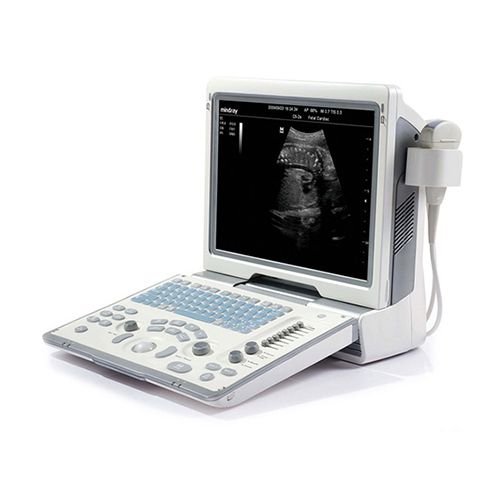
Ultrasounds are an increasingly common form of diagnostic imaging studies, used in the offices of many doctors - including podiatrists. Ultrasounds use high-frequency sound waves to create images of the inside of your body.
Several things happen during a typical ultrasound. First, the doctor applies a special gel over the area that is being imaged. In a podiatrist’s office, this will be a part of your foot or lower leg. Then the doctor runs a device called a transducer over the area. The transducer sends soundwaves into the body. When sound waves hit objects, in this case the tissues, blood vessels, and other structures in your lower limbs, the sound waves echo or bounce back. When the transducer receives these echo signals, it sends them to a computer that is then able to measure the sound waves and determine the location, size, shape, and consistency of the structures that we are trying to see. These readings produce pictures in real time, which are displayed on a computer screen and can be reviewed to diagnose the foot or ankle problem.
Ultrasounds are incredibly useful as a diagnostic tool for podiatrists. They can be used to diagnose a variety of foot and ankle problems. These include injuries, such as plantar fasciitis, Achilles tendonitis, sprains, or fractures, as well as arthritis, joint damage, neuromas, and soft tissue masses. By imaging the arteries in the legs, ultrasounds can also be used to screen for peripheral artery disease (PAD), a condition that causes poor circulation in the lower limbs. Once you have gotten a diagnosis and begun treatment, ultrasound imaging is also helpful for monitoring the condition of the foot or ankle to see if treatments are effective.
Ultrasounds provide a great deal of detail and information to help a podiatrist make the right diagnosis and prescribe the right treatments. They are safe, non-invasive, painless, and do not use radiation. Ultrasounds are also typically less expensive than other types of imaging studies and do not require any extra preparations on your part prior to the scan.
For more information about how ultrasounds can help your feet, please consult with a podiatrist.
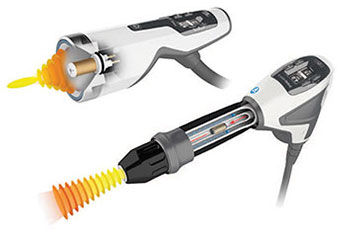
In Western medicine we are most familiar with treatment via medication or surgery. For chronic musculoskeletal problems(MSK) sometimes physical therapy may be recommended
if drug therapy fails and before surgery. The latter is a form of ‘Physical Medicine’, the application of some external force to the body inorder to effect some diminishing of symptoms and/or speed healing. Massage therapy is ancient. The adage ‘RICE’ / rest, ice, compression, elevation is still commonly employed for a sprained, swelling ankle. At physical therapy the therapist may apply electrical stimulation or deep heat through ultrasound to the injured tissue.
Shockwave’ for chronic MSK problems was originally developed in Europe decades ago. It involves not an electric shock but pressure wave pulses of specific frequency and intensity sent through the targeted tissue. When first used in the U.S the device was the size of a large cabinet and cost a quarter million dollars and therefore was often rented for a session and brought to the doctor’s office. The energy pulses were quite high intensity so the therapy was performed under some form of anesthesia and in one session.
Fast forward to today and the types of devices have expanded and the size and cost of the machines have dramatically diminished. Today the more common device in North America produces a ‘radial’ pressure wave ( EPAT, by Curamedix). This type of wave is most effective with soft tissue; chronically inflamed ligaments around joints, tendons and peripheral nerves ( Morton’s Neuroma in the foot). ‘Focused’ shockwave(FSW) is similar to the original device but lower intensity. It is most effective where soft tissue is anchored to bone; chronic inflamed areas of tendon or ligament ‘insertion’ to bone ( chronic plantar fasciitis, insertional achilles/peroneal/tibial tendonitis in the foot). These devices are table top in size and require no anesthesia and treatment is delivered over 3 -5 sessions lasting 10-15 minutes with intensity adjustable to the patient’s tolerance during each session.
Dr. Horowitz has experience with both EPAT and FSW devices and now has both available in his Bowie office. He uses devices from Curamedix/ Storz from Germany. These are the devices used in most research studies in the US and their effectiveness in treating chronic MSK problems is impressive. In his experience, Dr. Horowitz often finds that combining both EPAT and FSW brings the best results.
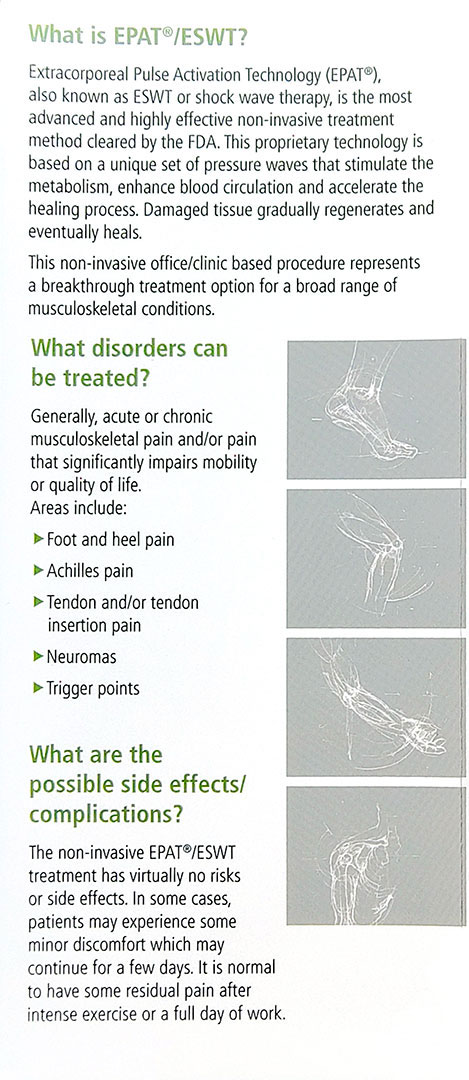
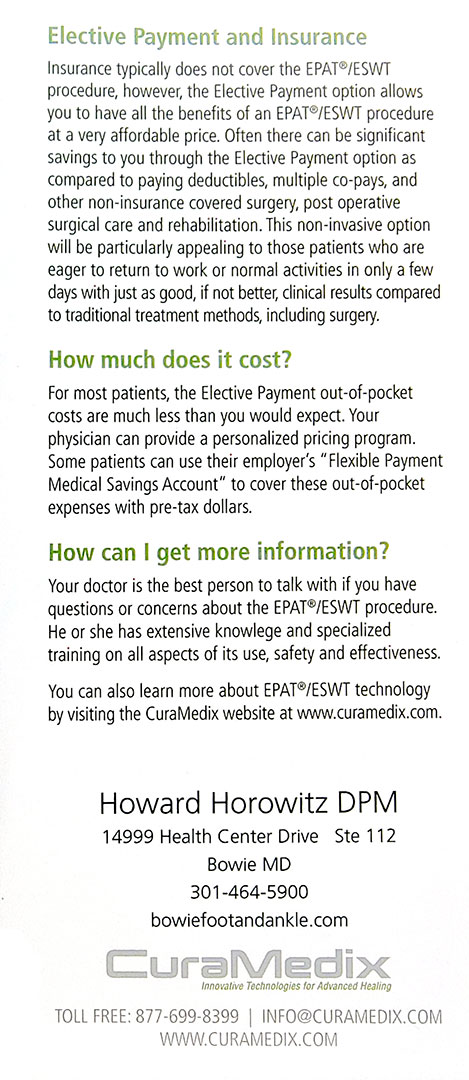
 EPAT Patient Brochure
EPAT Patient Brochure